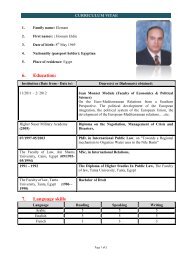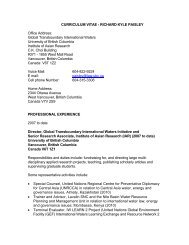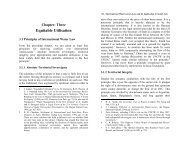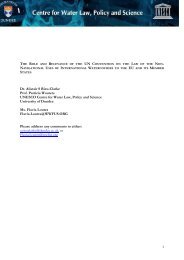Upreti, Trilochan, International Watercourses Law and Its Application ...
Upreti, Trilochan, International Watercourses Law and Its Application ...
Upreti, Trilochan, International Watercourses Law and Its Application ...
You also want an ePaper? Increase the reach of your titles
YUMPU automatically turns print PDFs into web optimized ePapers that Google loves.
Equitable Utilisation / 111 112 / <strong>International</strong> <strong>Watercourses</strong> <strong>Law</strong> <strong>and</strong> <strong>Its</strong> <strong>Application</strong> in South Asiain an equitable <strong>and</strong> reasonable manner. Such participationincludes both the right to utilize the watercourse <strong>and</strong> theduty to cooperate in the protection <strong>and</strong> developmentthereof, as provided in the present Convention.”Each watercourse has unique features that dem<strong>and</strong> separatesolutions. However, the justifiable principle to address eachcircumstance is that of reasonable <strong>and</strong> equitable utilisation. Itembraces equity, rationality, fairness, justice, equality <strong>and</strong> otherimportant elements of sustainability. In determining whether ause is equitable or not, factors relevant to equitable <strong>and</strong>reasonable utilization as envisaged in Article 6 of the UNCIWshould be considered: 22“1. Utilization of an international watercourse in an equitable<strong>and</strong> reasonable manner within the meaning of article 5requires taking into account all the relevant factors <strong>and</strong>circumstances, including:(a) Geographic, hydrographic, hydrological, climatic,ecological <strong>and</strong> other factors of a natural character;(b) The social <strong>and</strong> economic needs of the watercourseStates concerned;(c) The population dependent on the watercourses in eachwatercourse State;(d) The effects of the use or uses of the watercourse in onewatercourse State on other watercourse State;(e) Existing <strong>and</strong> potential uses of the watercourse;(f) Conservation, protection, development <strong>and</strong> economyof use of the water resources of the watercourse <strong>and</strong>the costs of measures taken to that effect;(g) The availability of alternatives, of comparable value,to a particular planned or existing use.2. In the application of article 5 or paragraph 1 of this article,watercourse states concerned shall, when the need arises,enter into consultations in a spirit of cooperation.22 Ibid.3. The weight to be given to each factor is to be determinedby its importance in comparison with that of other relevantfactors. In determining what is a reasonable <strong>and</strong> equitableuse, all relevant factors are to be considered together <strong>and</strong> aconclusion reached on the basis of the whole.”Again, the role of equity is relevant in fixing the conditions ofwhat is equitable <strong>and</strong> reasonable use of such waters. Insummary, these rules are meant to resolve any conflict ordispute between the contestant states in a fair manner. 23 Theserules clearly set out the conditions <strong>and</strong> prerequisites that needto be taken into consideration when determining whether a useis equitable or not.The use of an IWC should be undertaken in such a way that itwill not prejudice or be harmful to any other watercourse states.The obligation not to cause any harm to the other watercoursestate is an inseparable part of equitable <strong>and</strong> reasonableutilisation. The other aspect of equitable utilisation is to sharethe benefits <strong>and</strong> costs of any watercourse project developed bya watercourse state. This implies that if work done by anupstream state yields any benefits for the downstream state, itmust be shared on the basis of a cost benefit-analysis;otherwise, it could be a case of unjust enrichment. 24Furthermore, equitable utilisation requires a continuous processof giving information, negotiation <strong>and</strong> cooperation among theriparian states for the beneficial use of a shared watercourse. 25The rule of equitable utilisation was predominantly developed<strong>and</strong> enunciated for the division, allocation <strong>and</strong> sharing ofmarine resources <strong>and</strong> IWC’s among contestant states. Equitableutilisation has emerged as a rule of customary international law<strong>and</strong> is the cardinal rule in the area of delimitation of the23 Supra note 1, pp. 16-25.24 Factory of Charzow case (1928), PCIJ Reports, p. 47.25 Supra note 4, p. 548; S. C. McCaffrey, The <strong>Law</strong> of <strong>International</strong><strong>Watercourses</strong>, Oxford: Oxford University, 2001, p. 340.












